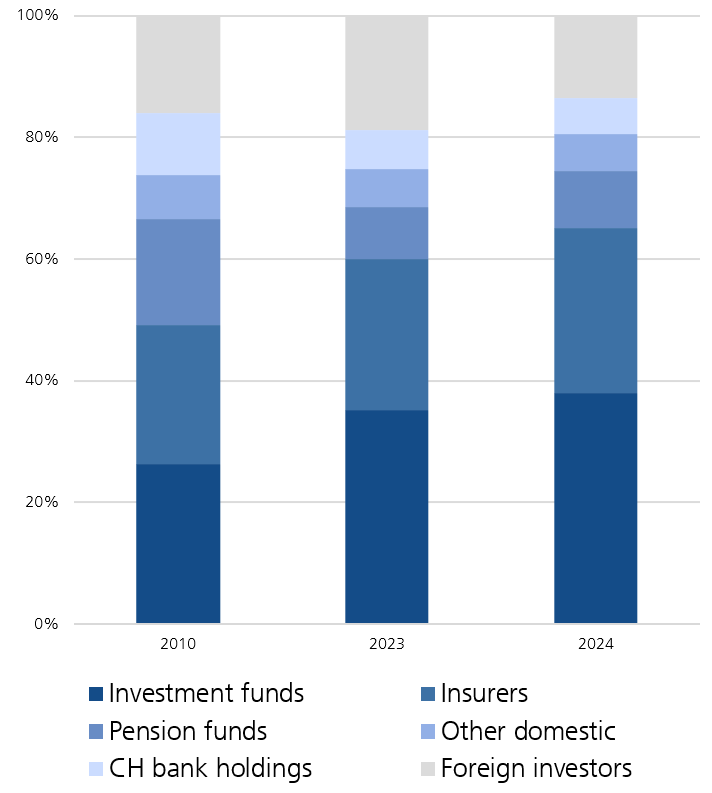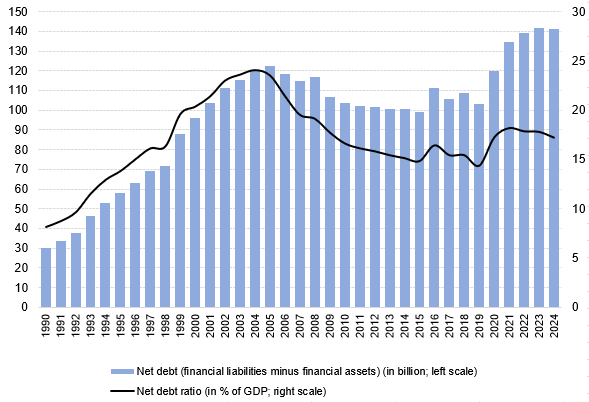Federal debt
Switzerland's level of debt is low by international standards. But how high is the federal debt and what is its composition?
Brief summary
Net federal debt stood at CHF 141 billion at the end of 2024, which corresponds to a debt ratio of 17.2% of GDP.
Switzerland's level of debt is low by international standards. The Confederation has the debt brake to thank for this. Following its introduction, it allowed for a considerable reduction in federal debt. However, debt rose sharply again between 2020 and 2022 as a result of the COVID-19 pandemic. The Confederation made around CHF 35 billion available to cushion the economic and health impact.
The coronavirus-related debt is reflected in the shortfall in the amortisation account. This shortfall, which resulted from extraordinary expenditure less extraordinary receipts, amounted to CHF 26.8 billion at the end of 2024 and must be eliminated in accordance with the Financial Budget Act (FBA). Parliament chose to adhere to this complete elimination, but extended the timeframe for doing so. This debt is to be reduced again by 2035 (with the possibility of an extension to 2039), using future structural financing surpluses in the ordinary budget and extraordinary receipts arising from the profit distribution by the Swiss National Bank.
What is the composition of federal debt?
Around CHF 83 billion of the debt is money and capital market debt. The Confederation's net debt also includes other liabilities, such as outstanding payments vis-à-vis taxpayers, cantons or federal enterprises. Net debt consists of total liabilities less non-administrative assets.
How does the Confederation take on debt?
In order to raise borrowed capital, the Confederation issues debt instruments, so-called Confederation bonds and money market debt register claims. These debt instruments are securities and, like other securities, can be freely traded by the holders during the term.
- Money market debt register claims are short-term borrowings, i.e. loans, mostly with a term of three months and a maximum of 12 months.
- Confederation bonds guarantee more long-term borrowing and have maturities of up to 50 years.
The Confederation pays a price for its debt, i.e. debt interest. This totalled CHF 1.24 billion in 2024.
From whom does the federal government borrow?
As the money market and capital market instruments issued are traded and the name of the holder is not registered, the federal government does not know exactly who holds them. However, the statistics of the Swiss National Bank give an indication of the likely composition of the Confederation bond investor base: domestic investment funds and insurance companies account for a large proportion, foreign investors represent around 14%, and the remainder is shared by pension funds, banks and other domestic investors. Consequently, most of the federal debt is owed to domestic institutional investors.

Press releases on the topic
Second 2025 extrapolation confirms financing deficit
The Federal Council took note of the current end-September extrapolation on 29 October 2025. The Confederation is reckoning on a financing deficit of CHF 0.6 billion for this year. The expected deficit is thus likely to be CHF 0.4 billion higher than forecast in the June extrapolation. However, the deficit is smaller than originally budgeted.
2026 budget with integrated task and financial plan for 2027 to 2029 available
Effective immediately, the 2026 budget is available in electronic format on the website of the Federal Finance Administration (FFA). The hard copy will be released in mid-September.
First extrapolation for 2025: financing deficit of CHF 200 million
The Federal Council was informed about the current extrapolation on August 13, 2025. According to this first extrapolation, the Confederation is anticipating a financing deficit of CHF 200 million for this year. A deficit of CHF 800 million had been budgeted. The improvement can be explained primarily by much higher tax receipts.
Federal Finance Administration FFA
Switzerland - 3003 Bern


